Learn The Court Cards Fast: Reading Court Cards As Dualities
Learn the Court Cards Fast: Reading Court Cards as Dualities
I’m not sure how helpful this post will be to others as it’s based very much in my own personal understanding of the court cards. I struggled for a very long time until I just abandoned most of what I’d read about them and began to understand them in the context of the rest of my own frameworks.
I think a common understanding of them is that you start as a Page and work your way up to being King. They often get read as “How much have you mastered the ideals of the suit?” with page being hardly at all and the King being the absolute best. It’s very hierarchical, top-down, and it’s not only sexist with regards to the Queen, but more generally invalidating of what the other cards have to offer in their own right.
I have come across alternative readings of the Court Cards but none of them really clicked until I started reading them as dualities.

The first duality I see in court cards is between the material/work and the ideals of each suit. Pages and Knights are focused on the work of each suit. They are carrying out the functions of their court, each with different advantages and disadvantages.
Unfocused vs. Focused Work
Pages, while perhaps less experienced, don’t engage with the work with the same ferocity of the Knights. Their lives tend to be more balanced, they tend to be more of the Jack of All Trades. There’s a real trade off with not being specialized. They’re versatile, flexible, ready to learn and change. But they can’t execute to the degree that a Knight can, might get easily distracted or side tracked. When not showing up in a signifying role, or showing up specifically in an action position, they can also sometimes point toward gossip or rumors.
Knights, on the other hand, are fierce to a fault. They are specialized, focused, and honestly kind of terrifying to me personally. They are the ideals of the suit, weaponized, constantly in motion. They are coming to fuck your shit up. They’re not balanced though. They’re rigid, don’t change course easily, and are stubborn to a fault. But they are also undeniably effective. They do what they set out to do, they are reliable, they will fight until the battle is won. When not showing up in a signifying role, or showing up in an action position, they can also point toward news or a reversal of luck.
Internal vs. External Ideals
Regents embody the ideals of the suit in their highest form. They are twin forms of mastery. And much like real regents, they’re often unattainable. I find in readings they serve as reminders, lessons, or status relative to other people in a situation. We might be a page of wands in an art class but a queen in our own families. I find that the lessons of the regents are much less absolute than the Major Arcana.
Queens symbolize the internal mastery of the ideals of the suit, people who’ve attained a deep understanding of the suit as it applies to themselves and those closest to them. They often work behind the scenes and their mastery isn’t always given its fair due by others. Their skill is no less refined and important though. Queens perform the kind of work that can only be done in private. They are masters of growth, healing, and wholeness in terms of their suits. For these reasons, they’re not less dangerous or effective than Kings. Their work may not always be seen but it is always deeply felt.
Kings symbolize the external mastery of the ideals of the suit, people who are publicly lauded and recognized for their expertise, passion, and skill. They are leaders, influencers, and tastemakers. They set the pace and the terms of engagement for the group around them. They often receive praise or scorn for their actions regardless of the work they actually do because their reputation proceeds them. They are undeniably skillful, especially with regards to groups of people rather than individuals. While Kings derive it from different sources, their influence is what makes them truly formidable.
Conclusion
Again, these are just my thoughts. They’re just another framework to smash up against what you already know and see what sticks. I find the duality or dualities model for the court cards to really help me and I’ve had much better luck interpreting them in readings for myself and others since building it. But it’s by far not the only way.
Another note – I’m nonbinary and I don’t consider the Queen and King to represent feminine and masculine energy of a suit like a lot of people write about. Even without the binary being alienating, I think it’s important to develop frameworks that challenge conventional gender “energy” interpretations when it comes to court cards. I’m definitely interested in how others have worked on this as well.
As always – hope this helps and if you have any questions please let me know!
*I never claim my way is the one true way. Take what is useful and leave the rest.
**If you wind up using this stuff in another setting, I’d really appreciate it if you could cite me. This is my art. Don’t steal, please credit.
-
 wait-wait-wait-what liked this · 1 month ago
wait-wait-wait-what liked this · 1 month ago -
 miameirohara reblogged this · 2 months ago
miameirohara reblogged this · 2 months ago -
 rosebeautytarot reblogged this · 3 months ago
rosebeautytarot reblogged this · 3 months ago -
 wren-anastazia liked this · 3 months ago
wren-anastazia liked this · 3 months ago -
 carinasibila liked this · 5 months ago
carinasibila liked this · 5 months ago -
 spookysnackz liked this · 7 months ago
spookysnackz liked this · 7 months ago -
 pinklightdonut liked this · 8 months ago
pinklightdonut liked this · 8 months ago -
 gothsope liked this · 10 months ago
gothsope liked this · 10 months ago -
 edelwennae liked this · 1 year ago
edelwennae liked this · 1 year ago -
 cardslinger reblogged this · 1 year ago
cardslinger reblogged this · 1 year ago -
 camisado17 reblogged this · 1 year ago
camisado17 reblogged this · 1 year ago -
 unsettledtarot reblogged this · 1 year ago
unsettledtarot reblogged this · 1 year ago -
 celestial-puffin reblogged this · 1 year ago
celestial-puffin reblogged this · 1 year ago -
 fynnchbird liked this · 1 year ago
fynnchbird liked this · 1 year ago -
 serenitysva liked this · 1 year ago
serenitysva liked this · 1 year ago -
 velveteen-ghost liked this · 1 year ago
velveteen-ghost liked this · 1 year ago -
 praxling liked this · 2 years ago
praxling liked this · 2 years ago -
 redistrying liked this · 2 years ago
redistrying liked this · 2 years ago -
 nyktomancer reblogged this · 2 years ago
nyktomancer reblogged this · 2 years ago -
 nyktomancer liked this · 2 years ago
nyktomancer liked this · 2 years ago -
 asimozouzouna reblogged this · 2 years ago
asimozouzouna reblogged this · 2 years ago -
 anaelegance liked this · 2 years ago
anaelegance liked this · 2 years ago -
 xx-aryn-420-xx reblogged this · 2 years ago
xx-aryn-420-xx reblogged this · 2 years ago -
 wind-singer liked this · 2 years ago
wind-singer liked this · 2 years ago -
 scarlet-sappho liked this · 2 years ago
scarlet-sappho liked this · 2 years ago -
 corvusque liked this · 2 years ago
corvusque liked this · 2 years ago -
 learningtoreadtarotcards reblogged this · 2 years ago
learningtoreadtarotcards reblogged this · 2 years ago -
 makthetarotreader reblogged this · 2 years ago
makthetarotreader reblogged this · 2 years ago -
 anonaemus liked this · 2 years ago
anonaemus liked this · 2 years ago -
 babywitchgaia reblogged this · 3 years ago
babywitchgaia reblogged this · 3 years ago -
 my-freak-machine liked this · 3 years ago
my-freak-machine liked this · 3 years ago -
 nefarious-virgo liked this · 3 years ago
nefarious-virgo liked this · 3 years ago -
 certainpeanutpursetaco liked this · 3 years ago
certainpeanutpursetaco liked this · 3 years ago -
 waywrdwitxh636 reblogged this · 3 years ago
waywrdwitxh636 reblogged this · 3 years ago
More Posts from Rosebeautytarot
Reading Reversed Cards Made (Slightly) Easier
Note: I’m still in a lot of pain but I can’t sleep and I want to write through this while it’s still fresh in my mind. I’ll probably schedule it for later in the day but just know that I wrote this at 1am fighting through a pretty intense autoimmune flare and it might strike a different tone than my other pieces.
My girlfriend has been following along with my May tarot challenge I have going, drawing cards every few days and catching up on prompts when she can. Over the weekend she pulled a reversed card for the first time since using her new deck – she hadn’t intentionally shuffled reversed cards in – and asked if and how she should read the card as the book for her deck didn’t list any reversed meanings.
Now the only reason I could advise her for her specific deck was that I’d seen people use it before and knew how others approach reversed cards. But it got me thinking about what of that advice applied more generally.
Not all decks come with reversed meanings described by the creator of the deck. Some decks have reversed meanings that come to be agreed on collectively by the community of people who study and use it. Some explicitly advise against it. But most – it’s really open ended.
So here are my thoughts.
Should you read reversed cards at all?
I respect people who decide not to read reversed cards. It’s a personal decision and if it doesn’t align with what you want or need from your practice and you’ve taken the time evaluate it then by all means don’t read reversed cards. Hell, if you don’t read reversed cards because you don’t want to try to remember another 78 meanings, I can respect that too. Just lay them down upright and shuffle them back in.
But there’s a lot lost in not reading them and I think it’s worth reflecting on that. In my view, the standard deck has enough “bad” or unpleasant cards in it as it is to at least touch on when things are lacking in a person’s life but I don’t know that it’s as helpful as reversed cards for getting at the truth and the root that lack.
In my personal practice, tarot cards upright are what I might refer to as “the natural course” or “the natural result”. In life, in our self-development and journeys, it is totally natural and even fruitful to have lows. Those lows lead to deeper self-awareness and aid in a person’s growth.
But reversed cards refer to, to borrow a therapeutic term, “stuck points”. Beliefs, behaviors, or experiences that have become so engrained that we operate from them as truths – even as we know they’re warped and harmful. These are lows that are not helpful, do not contribute to our growth, and keep us locked in the past.
For me personally, being able to locate those stuck points in a reading – both for myself and another person – is very important to me. Those are most often the points in a reading that have resulted in querents coming back to me weeks or months later to tell me they freed themselves of their circumstances and finally feel okay again. Hell, I’ve had that experience reading them for myself.
So should you read with reversed cards? It’s personal, but I recommend trying.
Reversed Cards as Shadow Self/Dark Side
This is the approach I most often use for decks that don’t have their reversed meanings listed.
Reading with this mindset helps if you have some understanding of religious shadow work – spiritual work undertaken to confront our fears and reintegrate those dark and messy parts of ourselves we’re deeply uncomfortable with – but having a working definition will do just fine.
Another way of understanding it might be to think of the card’s dark side. Even the most admirable people have flaws that can hurt other people and themselves. The figures of tarot cards are no different.
I think understanding this style works better with a few examples.
Take the High Priestess. Upright she is the beacon, the kind of intuition and knowledge that comes from inhabiting a liminal space. But reversed, she can be a very isolated figure, one who withholds what she knows or at least doesn’t offer it freely.
Or take the Three of Cups. Upright it embodies deep friendship and camaraderie. But reversed it can mean lacking privacy, a feeling of those your care about encroaching on your autonomy or relationship. Having friends is absolutely a great thing, but friends can also distract, smother, and take us away from more important tasks and people.
The point here is to consider the drawbacks of each card, even the happiest among the deck.
When it comes to cards with less happy meanings, consider what I wrote above about stuck points.
For example, the Nine of Swords upright is about anxiety and dread, usually merited, that disrupts. But the Nine of Swords reversed for me can mean deep anxiety we’re not fully aware of that disrupts but is too deeply buried to really grapple with. It can also mean anxiety that has come to rule a person’s life regardless of whether there is an impending doom of some sort. It’s the upright meaning of the Nine of Swords but as a situation that blocks a person’s growth rather than serving as a natural part of a person’s progression.
Reversed Cards as Retrograde
This approach for me is far more recent and I’m still testing it out, but it’s been helpful enough that it feels worth mentioning here.
Recently, I got a question about planetary associations of tarot cards which is a field I am not versed in at all. But it did get me thinking. I’ve often referred to tarot cards as existing in a personal constellation and thinking of each card as a star or a planet in the sky was a refreshing view. It got me wondering about those cards as being in retrograde.
Now, I fully admit that I don’t fully understand retrograde as an astrological term but my barest understanding is that when a planet starts “moving backwards” through the night sky, the area that planet rules over stops running as smoothly.
So for a card to be reversed, or “retrograde” in this model, it would raise the question: what happens when the situation in the card stops moving smoothly?
For instance, applying this take to the Three of Cups reversed could result in reading it as a sign that friendships are faltering, that people are growing apart, that there is too much focus on the individual rather than the group.
Like I said, I’m still experimenting with this approach, but I wanted to present it for other people to fine tune. I doubt I’m the first person to write about this and I hope others will chime in with resources here. I’m having very good luck with this approach.
Conclusion
I think there’s a way to combine all this but it’s also fine to take the parts that work for you and run with them. I just wanted to present what I know for people who still might be figuring out how they want to use reversed cards in their practice.
I wish you the best of luck! May your readings be accurate, fruitful, and transformative!
*I do not claim my way is the one true way so take what is useful and leave the rest.
**If you wind up using this stuff in another setting, please credit me. This stuff is my art. Don’t steal, please credit. Thanks!
Reading Tarot Cards Without Spreads
I’ve been putting off writing this post for a while because every time I go to draft it I realize that I don’t have fully have words to explain how I intuit cards without spreads. Normally, when I suggest it to students, they come up with their own unique way so I think it’s totally possible to learn by just diving in and trying it. I’ve taken some extra time lately though to really dig into what it is I do but I still feel like I come up short. So I present this as best I can and I might come back and add notes or revise it later as I have new realizations. In the meantime, here are my thoughts.
Drawing 1 – 4 Cards
For me, when I’m only drawing a few cards, there’s no real placement to read. I almost always take them as “This is what’s going on” or “This is what you need to know”. I use these more as a dialog between me and a spirit or me and the universe. So, for instance, I might pull 3 cards for “What’s going on?” and realize I’m neglecting my physical health and the reasons why. Then I can either stop and problem solve on my own with that new perspective or pull another set with a new question like “What do I need to do?”
It’s conversational and I like it because it really breaks the idea of one card answering one question that you get used to when you read with spreads. I think that’s really vital, especially if you’re doing lengthy interactive readings for querents who might request follow up cards or clarifications cards. When you get out of the “1 card for 1 question” mentality, that process becomes much more intuitive and smooth.
So there’s not much to add here. I really see drawing a few cards like a conversation with a person. They’re not going to always sit there and tell you a story in order – they’re going to highlight how they felt, what it meant, the why and the how. It’s very similar in my experience with pulling a few cards without a spread.
Drawing 5 + Cards
This is where I realized I’ve built up a combination of frameworks in my head for when I pull a lot of cards with no spread. A lot of people will say look at where the characters in the cards face to draw connections, count the major arcana and court cards to know how many people are involved – and I think that style can be really fruitful but it’s not what I know so I’ll let others speak more to that.
I do recommend pulling cards and not flipping them over until you’re done laying as many as you feel are needed for a question, just to prevent yourself from trying to make the story as you lay them down, but it will work just fine usually either way.
This is a rough diagram of how I interpret them.

Observant readers may note similarities between this diagram and my spiraling spread. It’s true they both inform each other, but the difference is that I’m not drawing a card for every “spot” on this diagram. I lay out the cards and then determine their meaning relative to each other rather than the numbered spot they occupy.
For instance, spreads done this way are often bottom or top heavy, pointing toward either a lot of outside influence or a lot of deeply rooted shadow self/unconscious blocks. They’re often left or right heavy too, meaning either the past was particularly relevant to the present or the universe is gearing up for some big shit in their/your life. There might be several cards in the self/present spot which might point to leading a double life or the strain of conflicting roles. I will generally let the suit of the present/self cards determine the area of life the reading is most relevant to.
If a querent is more interested in what to do at the end of a spread like this, then I might use one of my quick diagnosis spreads to gain a little more insight. Or draw 1-4 cards conversationally like I described above.
Conclusion
The real pro of reading without spreads is the flexibility of it. It really helps develop intuition and pattern regconition. It’s also super helpful for developing your own regular spreads. Several of my quick diagnosis spreads were patterns I kept seeing so I codified them into an actual spread. I really hope you try reading without spreads. Borrow from this method if you like, but I think developing personal systems works the best.
Best of luck!
*I do not claim my way is the one true way so take what is useful and leave the rest.
**If you wind up using this stuff in another setting, please credit me. This stuff is my art. Don’t steal, please credit. Thanks!
Conceptions of the Self through Spreads
If you’ve followed me at all you know I like frameworks. I have some that I’ve developed or worked with for many years but there are others I consult less regularly and still enjoy. The following are spreads based on models I’m not an expert in. I present them here mostly as a way to introduce people to the ideas they contain. If you like any of them, I encourage you to explore it more deeply and see how it can be helpful to the shadow work you might be doing.
These are meant to be fun and I’ve not tried each of them personally yet so I can’t vouch for them. But I hope they inspire people to develop their own conceptions of self.
Psychoanalytic
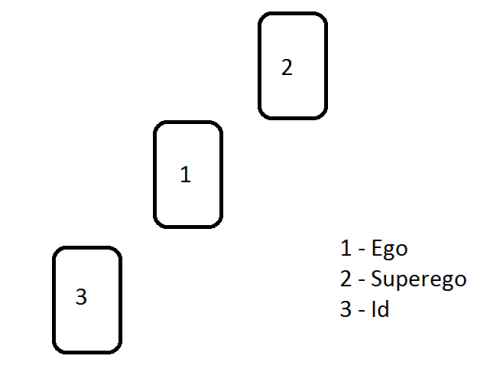
Ego – the part of the self that we normally think of as “the self; it is the self as we known ourselves to be
Superego – the part of the self that’s co-created with other; shaped by social acceptability and how we’re raised to think and act.
Id – the part of the self that is below conscious awareness but that influences our behavior, often deals with unseemly desires or parts of the self that are too socially unacceptable to even acknowledge
If you liked my Four Fear Types post, you’ll like Pete Walkers work. It builds on the psychoanalytic/psychodynamic theory of the self. He puts forward the idea that in people who’ve experience abuse or neglect early on, the Ego is diminished and the Superego takes its place. The Superego in some models is synonymous with the Inner Critic.
Self Discrepancy Theory

Own Actual – how you actually are, what patterns you currently have, what is realistic for you
Own Ideal – how you view yourself to be, your higher self, your best self
Own Ought – how you feel you should be, the standard that you hold yourself to
Other Actual – how you actually are with others, what’s realistic for you with others
Other Ideal – how others view you to be in the best light, how other idealize you
Other Ought – how others think you ought to be, the standard they hold you to
The Wikipedia page for this is actually really good for this theory. It has a really good chart for examining types of conflict that occur between the selves in this model. I’d really suggest supplementing this reading with it. I like this one because it points out that the self doesn’t exist in isolation, it’s constantly evolving and being co-created with others in your life for better or worse.
Elemental
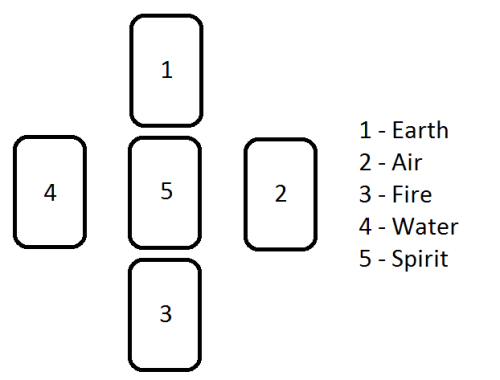
Earth – Home, Family, Finances, Physical Health
Air – Intellect, Communication, Logic, Anxiety/Attachment
Fire – Passion, Spirituality, Drive, Anger
Water – Emotions, Intuition, Romance, Fluidity
Spirit – Core Self, Energy, Connection to the Universe
I like the classical elemental model of the self sometimes. It can help to understand my life is not one set of experiences of efforts. It’s not singular in any way. It’s a good way to check in with myself and make sure I’m dividing my energy among different areas and not neglecting anything too much. I don’t use it too often but I still enjoy it. Apply your own training with it and create your own spread if you want. I’d love to see more variations with this one.
Socioecological
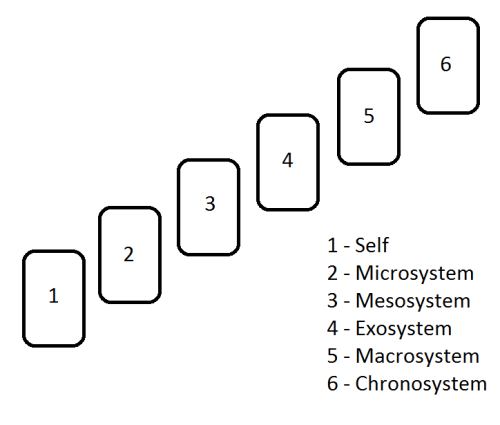
Individual – the Self, your characteristics
Microsystem – Family, School, Church, Friends, Job
Mesosystem – Neighbors, Family Friends, Friends of Friends, Network
Exosystem – Mass Media, Industry, Local Politics
Macrosystem – Culture, Societal Ideals and Values
Chronosystem – Life transitions like divorce/marriage/death/birth, your history
One of my favorite models I learned during my brief stint in social work. The idea is that the self is created and influence across multiple nesting levels of influence. The bigger the level, the broader and all encompassing the influence but the less acute it generally is. Chronosystem kind of bucks that trend a little a lot of people don’t use it. But I liked using this as a model for the self because again it reminds us that we’re influenced by a whole host of people and our selves are not created in isolation.
Myers-Briggs
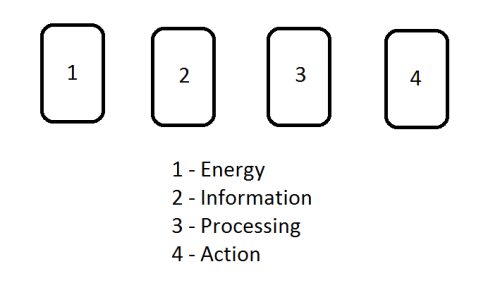
Energy – Where you gather your energy
Information – How you gather your information
Mode of Synthesis – How you work through information
Action – What you do with information
This one is purely for fun. I enjoy Meyers-Briggs even if it’s been pretty well debunked. Some folks might now know what area each letter roughly corresponds to. This was how it was explained to me by a woman who used to travel to different companies to administer the test and give seminars for employees on how to use it. I find the idea that we’re defined by our energy and how we interact with information really interesting, so I included this one here.
Conclusion
I hope these were an entertaining way to learn about some models of the self. If you’re an expert in any of these models and you want to expand on them – especially with regards to how they’ve influenced your shadow work – please reblog and add on! I only have a passing familiarity with these but they’re important enough I wanted to mention them.
As always, take the best and leave the rest and if you have any questions let me know!
A big thank you to all my Patrons! This post wouldn’t have been possible without sewceress in particular!
If you enjoyed this post consider supporting me on Patreon or tipping me on Paypal!
How to Use the Spiral Spread Method to Level Up Your Tarot Readings
I could wax poetic about big spreads. @goodbonestarot has written on why you should pull more cards even as a tarot newbie which I wholeheartedly agree with. There’s something really aesthetically and spiritually satisfying about having a big spread laid out on your floor, maybe a couple candles going to set the mood while you bask in a waterfall of truth. Or maybe that’s just me.
Either way, big spreads can help you understand a situation complexly, provide a lot of opportunities for creative problem solving, and help you gain a less prescriptive/more intuitive understanding of how to conduct your tarot readings. So there’s a lot to be gained from reading a big spread from time to time.
But big spreads are also intimidating and setting out to do a massive one all in one go can obscure some of the insights you might get along the way. Which is why I recommend spiraling them out as you need for the occasion. Below I give an example of how I do this with a “spiral spread” that I use but you can find plenty of other spreads that would work with this method too.
Phase 1: Six Cards
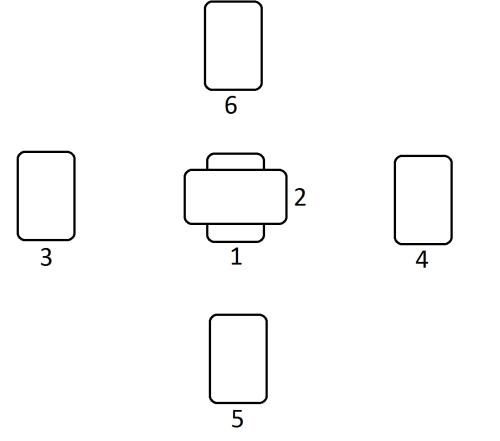
1: Signifier/What do you bring to the situation?
2: Challenge/Situation
3: Past
4: Future
5: What’s at the root of your situation?
6: What advice do gods/spirits/the Universe have for you?
This level is my go-to spread for reading at parties right now. Remember that ask where I talked about accidentally making a tough guy start crying at a party? That was this spread. So even at this level it can really pack a punch. It’s enough depth that a querent usually feels like they got a proper reading but not deep enough that the details start to get lost which I feel like is important when reading in busy social situations.
Phase 2: Ten Cards
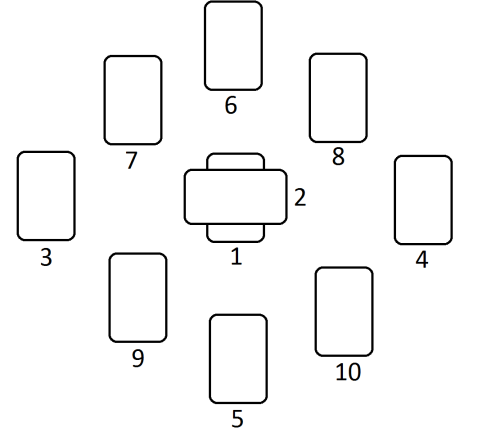
1: Signifier/What do you bring to the situation?
2: Challenge/Situation
3: Past
4: Future
5: What’s at the root of your situation?
6: What advice do gods/spirits/the Universe have for you?
7: How do gods/spirits/the Universe see your past?
8: How do gods/spirits/the Universe see your future?
9: How does this root relate to your past?
10: How does this root relate to your future?
This was my go-to spread for many many years. I used it more when I was hanging out with friends in lowkey settings where I had plenty of time to read it out. You’ll see here that what’s built in here is the relationships between forces acting on a person’s life. If I’m going to draw extra cards, that tends to be where I get the most bang for my buck. Relationships fill out the spread and add complexity and depth without opening a whole new can of worms. This level strikes a good balance here I think.
Phase 3: Fifteen Cards
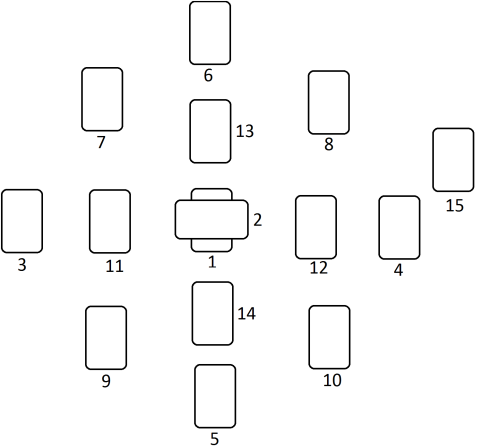
1: Signifier/What do you bring to the situation?
2: Challenge/Situation
3: Past
4: Future
5: What’s at the root of your situation?
6: What advice do gods/spirits/the Universe have for you?
7: How do gods/spirits/the Universe see your past?
8: How do gods/spirits/the Universe see your future?
9: How does this root relate to your past?
10: How does this root relate to your future?
11: How did your past lead to the present?
12: How will your present lead to your future?
13: How do you relate to/how is your relationship with your gods/spirits/the Universe?
14: How do you relate to the root of the situation?
15: Ultimate Outcome/Resolution
I’ve only used this level of the spread a few times over the years. Usually for myself but I have on occasion used it for friends who were really going through a rough patch. It’s definitely a lot to take in which is why I suggest laying it out and reading it in phases. I consider cards 11-15 to really be more along the lines of clarifying cards than strictly part of the spread. Which is to say, pull the ones you feel are most important. I’ve pulled them just for the root or just for the future - whatever make the most sense for your situation.
Closing Thoughts
Big spreads really do ask you to rely on your intuition and if that feels uncomfortable starting out, know that that discomfort is normal. We spend a lot of our lives being told to trust sources of information other than ourselves and while a lot of that is done for good reason, it can alienate us from all the good knowledge we have within. So big spreads are an opportunity to reclaim it.
I really recommend writing down insights as you go or having another person do it for you because big spreads turn up a lot of them, often ones that reveal even more when considered together. You don’t want to forget anything along the way. Also seeing how you see a card at one level before you lay down the next phase can also be very illuminating.
If you’ve not done a big spread before or it’s been a long time, I really recommend giving it a go. Life is complex, it’s important to be comfortable with spreads that are complex too.
I hope this helps! If you have any questions, let me know!
*I do not claim my way is the one true way so take what is useful and leave the rest.
**If you wind up using this stuff in another setting, please credit me. This stuff is my art. Don’t steal, please credit. Thanks!
Nonbinary November Tarot Challenge
I’ve been having such a great time doing @tarotprose’s amazing #MonthOfSpreads2 challenge that it inspired me to design another Tarot challenge to do in November.
As the holidays get closer, I tend to creep back toward the closet with regards to my gender. I throw on dresses more even when they make me uncomfortable and style my hair more like a pixie cut – not like the crew cut it is. I do this because I want the holidays to be fun and avoid conflict but the price I pay is not being fully myself in those moments. I wanted to set the tone but creating a challenge that helps me focus on my gender and being true to it even when the pressures of family and friends of friends make that hard.
Cis folks are welcome to participate. We all have complicated relationships with gender and how we perform it, even those who identify with their assigned gender. Examining it can help us unpack in what ways we uphold oppression too. Just know this challenge is created for trans folks, nonbinary ones in particular.
Use the hashtag #NonbinaryNovemberTarotChallenge
I’ll be randomly selecting 3 people who post their readings in that tag to win readings from me; one small (3-5 cards), one medium (6-8 cards), one large (10-14 cards). So the more you complete, the more likely you are to win. I’ll draw for the readings on December 4th so you’ll have a chance to catch up if you wish.
Complete the challenge at your own pace. Work ahead, skip days, catch up in a marathon session.
For brevity’s sake, prompts are below the cut. Happy Divining!
Keep reading
